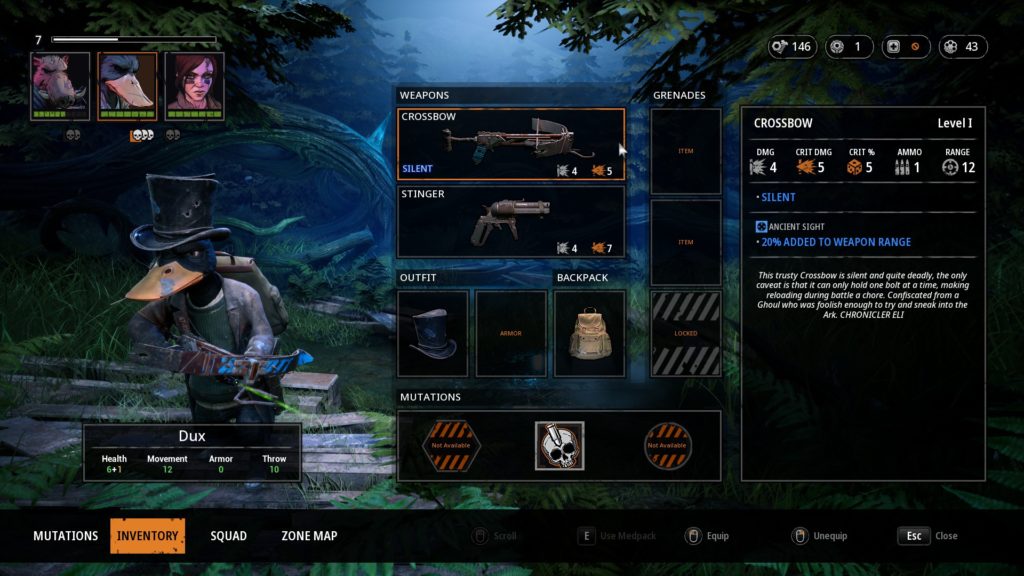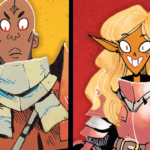
So far I’ve really been enjoying Mutant: Year Zero. So much, in fact that I’m now regretting not biting on the Bundle of Holding for the tabletop source material earlier this year. You play as stalkers Dux and Bormin, stalkers are brave souls who venture out into an area known as ‘The Zone’ to help carve out another slice of existence for themselves and their fellow survivors from a hostile and dead planet. MYZ takes the fun tactical elements of games like X-COM and humanizes them a bit with gritty, mutant, post-apocalyptic styling.
Gone are the sterile and somewhat procedural base building aspects of familiar titles and in their place, a hub populated with NPCs to banter and barter with. Known as The Ark, this hub is the place you call home but also the spot to go to between forays into The Zone. It’s in The Ark that you’ll exchange artifacts for upgrades and add-ons, buy and sell items, and progress the narrative by speaking to an enigmatic figure known as “the elder” as well as the other supporting characters. While there’s nothing wrong with the X-COM formula, I do find the narrative elements here to be far more compelling than the gravel-voiced faceless suitguy calling me “COMMANDERRRRR” every 8 seconds and then prompting me to dissect another alien or save some hapless AI civilians.

Wordplay intended, Mutant Year Zero feels like it does this all far more organically than X-COM ever did. In addition to the ways it strays from the norm is that the game focuses on the story of Dux and Bormin, the two main protagonists and the other mutants that join them along the way. Being that the game is more focused on their individual stories, nameless soldiers and permadeath don’t play a role here, unless you’re playing on turbo-badass difficulty mode. Progression is relatively similar though, as your stalkers level up they gain points that can be distributed in a talent tree like system for new mutations, which are basically perks.

The world building done here is done pretty well and I’m also a fan of the voice acting. There’s a certain charm in the characters unknowing tone about what came before them, referring to present day “us” as “the ancients” and thinking that “boom boxes” are literal explosives. Horizon Zero dawn did this well too, and I feel like it offers some tangible perspective and a bit of comic relief to an otherwise bleak landscape.
The game’s world map looks like it was pulled right from the tabletop RPG source book, albeit quite a bit more zoomed in. Pictured below is the MYZ in-game map (left) and the map from the pen & paper game’s core book (right).
Let’s drill into the combat and the UI a bit since this is the bread & butter of the game. First off I love that the grid is only actually recognizable inside of combat, the world otherwise feels hand-created and not like your characters are moving around on a grid. This very much represents the tabletop origins of the game to me, exploration is free form but once conflict breaks out you’re taking turns, tactically thinking, and weighing your options with each turn.
Within combat itself, it’s nice that at any given point when choosing where to move that the game draws a quick LoS and range indicators letting you know valid targets before even moving into the space. Feels like this and a few other quality of life tweaks done to the UI make MYZ stand out above some of its turn-based predecessors. Although I really did love Hard West’s as well. Combat math seems to always work out in quarter intervals. 25, 50, 75, and 100% chances to hit are all I’ve ever seen, to some this might be seen as “dumbed down” or simplistic, but I like the digestibility of it. It gives me a tangible example of how likely I am to succeed at something, I know any % could pull this off, but the quarter intervals are just…nice, I don’t have a great or logical explanation as to why.
Outside of combat there is a great deal of reward for going off the beaten path, and the world feels open, transitioning from one spot on the map to another is usually met with a short loading screen but I’ve got no qualms there. Beyond scavenging, and discovering the stories that unfold both narratively via the dialogue of your party members and their foes, there’s also a great deal of visual story telling in the environments.

These devs also worked on the Hitman games so naturally their penchant for stealth comes forward early in the game. Your stalkers can turn their lights out and creep up, hiding behind cover and basically getting a ‘surprise round’ (another tabletop staple) on their enemies with some careful scouting and planning. Utilizing silent weapons also means sometimes you can thin out a crowd of ghouls (the defacto bad guys) before even fully engaging by picking off those that wander out of camp to patrol.
It all feels really great in play, instead of having to meet head-on with every combat encounter, this adds another layer of finesse and potential “Yessss!” moments from players. The Stealth elements of the game are definitely a cool part, but I wouldn’t ever even venture to put “stealth” in a genre tag for the game. It’s a thing that happens, and can/does happen relatively often, but it’s not a stealth game

I’m not anywhere near done with the story so far so I can’t attest how well all of the mechanics hold up over dozens of hours of gameplay, or whether the story comes to any sort of satisfying conclusion, but so far I can say that the game play elements of MYZ are extremely satisfying. Again, this is only as far as I’ve gotten so far, about 4 hours in. There might be some stuff further on down the talent trees that’s just a no-brainer that put the game in easy mode or a huge narrative hole that makes no sense.
Then again, I’m not one to really care about continuity or plausibility if it’s fun, you know, because that’s what games are meant for. However, so far all of the choices I’ve had to make have felt relatively tough and combat almost always feels lethal, it’s definitely not hard to manage winding up with one or more of your stalkers bleeding out in the grass if you’re not careful.

The game looks gorgeous and I feel like they really nailed the atmosphere, especially searching around at night with the flashlight casting shadows among the trees and tall grass. I wish the zoom was allowed to get a bit closer to the characters, but it’s a minor gripe. The lip syncing of the characters dialogue is definitely not great, and the close up on a few of the stalker models in the inventory screen makes them look a little hokey, but I don’t think they were modeled to be looked at up close, hence the far zoom. It’s a stupid nitpick, especially for a $35 title. I think at that price you’re more than getting your money’s worth.
Overall I highly recommend giving Mutant Year Zero: Road to Eden a try if you’re curious about it, especially if you love turn-based tactical games, enjoy a robust post-apocalyptic universe, or just enjoy the casual banter between two friends who happen to be anthropomorphized human/mutant hybrids clinging to a threadbare existence murdering bad-dudes together and meeting new friends along the way. It’s available on Steam for PC, and on PS4 and XBOX digitally.




